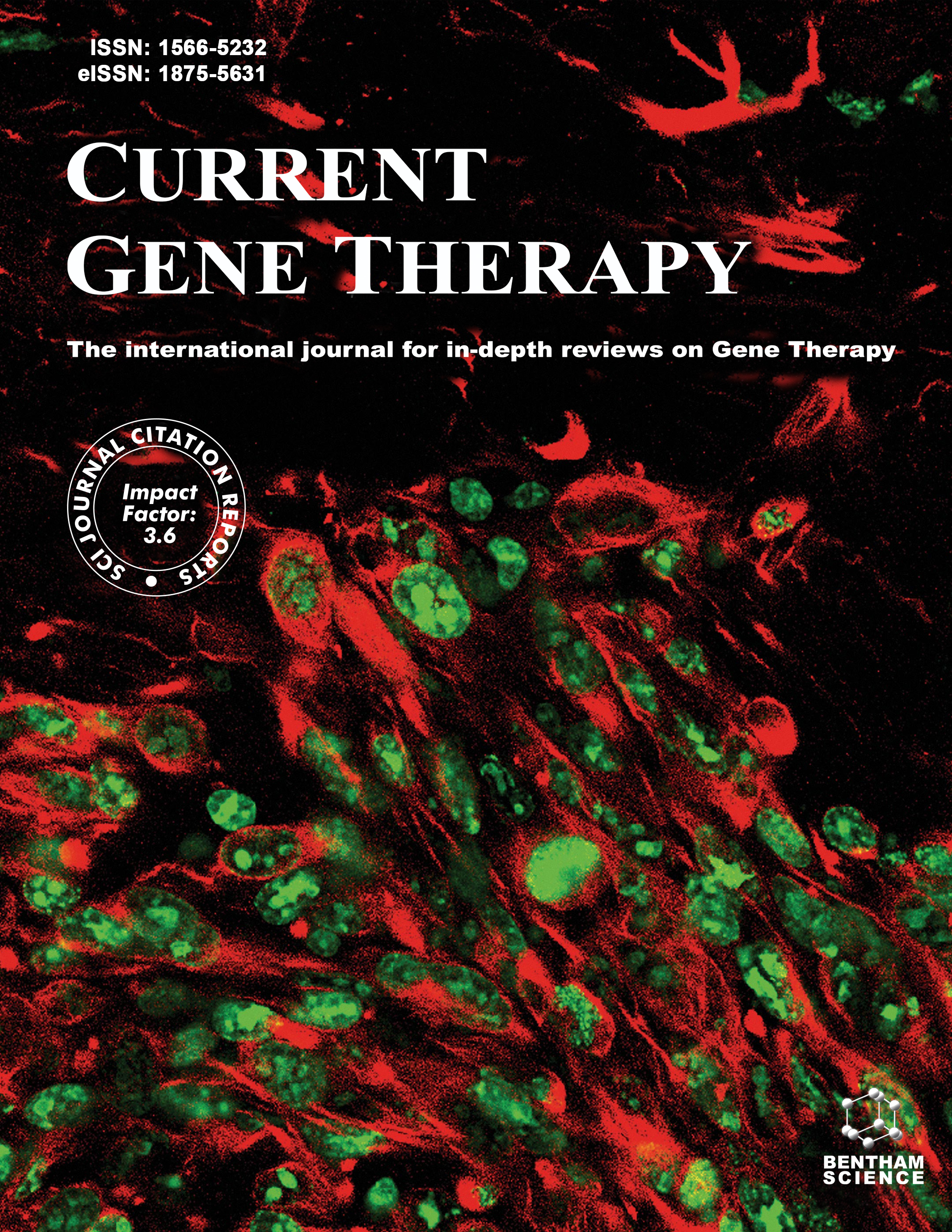- Home
- A-Z Publications
- Current Gene Therapy
- Previous Issues
- Volume 16, Issue 4, 2016
Current Gene Therapy - Volume 16, Issue 4, 2016
Volume 16, Issue 4, 2016
-
-
Haemophilia B Curative FIX Production from a Low Dose UCOE-based Lentiviral Vector Following Hepatic Pre-natal Delivery
More LessAuthors: Vincent Yu-cheng Kao, Sonia Ferreira, Simon N. Waddington and Michael N. AntoniouThe ubiquitous chromatin opening element from the human HNRPA2B1-CBX3 housekeeping gene locus (A2UCOE) is able to provide stable and cell-to-cell reproducible levels of transgene expression regardless of target cell genome integration site with efficacy demonstrated in adult, embryonic and induced pluripotent stem cells and their differentiated progeny in vitro and in vivo. Here we evaluate the ability of A2UCOE-based le Read More
-
-
-
Comparison of Tetracycline-regulated Promoters in Lentiviral-based Vectors in Murine Transplantation Studies
More LessAuthors: Maike Stahlhut, Teng-Cheong Ha, Michael Morgan, Axel Schambach and Olga S. KustikovaTetracycline-regulated systems with efficient temporal and dose regulation of transgene expression are useful for development of new physiologic/pathophysiologic experimental models and gene therapy approaches. Lentiviral vectors with improved tetracycline-regulated promoters help to overcome the existing limitations such as basal activity in the drug absence, poor inducibility or unstable transgene expression. T Read More
-
-
-
Immunogenicity and Therapeutic Effects of pVAX1-rv1419 DNA from Mycobacterium tuberculosis
More LessAuthors: Yan Liang, Xiaoyan Zhang, Li Xiao, Xuejuan Bai, Xiaomei Wang, Yourong Yang, Junxian Zhang, Jinying Song, Yinping Liu, Ning Li and Xueqiong WuBackground: Tuberculosis (TB) is threatening disease in China and new therapeutic agents and regimens to treat TB are urgently needed. Objective: In this study, a DNA vaccine expressing Mycobacterium tuberculosis (MTB) Rv1419 antigen was constructed and its immunogenicity and therapeutic effects were evaluated. Method: Normal mice and TB model mice were immunized intramuscularly three times at two-week intervals wi Read More
-
-
-
DOK3 Degradation is Required for the Development of LPS-induced ARDS in Mice
More LessAuthors: Ning Liu, Xiaofeng Liu, Xiaoou Li, Kaifang Duan, Yuming Deng, Xiuyan Yu and Qisheng PengIt has been reported that DOK3 protein negatively regulates LPS responses and endotoxin tolerance in mice. However, the role of DOK3 in the development of acute respiratory distress syndrome (ARDS) remains unknown. In this study, we showed that DOK3 is degraded in the lung tissues of LPS-induced ARDS. Through lentivirus transduction containing DOK3(K27R) via the intranasal route, we created a mice model, in whic Read More
-
-
-
Releasing of Herpes Simplex Virus Carrying NGF in Subarachnoid Space Promotes the Functional Repair in Spinal Cord Injured Rats
More LessBackground: Spinal cord injury (SCI) is a serious disease which can lead to bad consequence in patients. Gene therapies, as an effective strategy, have been developed for the treatment of several diseases. But the effect for the treatment of SCI is also waiting to be practiced. Objective: Here, we explored the effect of NGF administration carried by herpes simplex virus (HSV) in the injured spinal cord. Methods: Transgenic reco Read More
-
-
-
Cell Compatibility of an Eposimal Vector Mediated by the Characteristic Motifs of Matrix Attachment Regions
More LessAuthors: Tian-Yun Wang, Li Wang, Yu-Xin Yang, Chun-Peng Zhao, Yan-Long Jia, Qin Li, Jun-He Zhang, Yi-You Peng, Miao Wang, Hong-Yan Xu and Xiao-Yin WangThe characteristic sequence of β-interferon matrix attachment regions (MARs) can mediate transgene expression via episomal vectors in Chinese hamster ovary (CHO) cells. However, the host cells were from hamster ovaries, which are not suitable target cells for gene therapy. In this study, we aimed to evaluate the suitability of 12 different human cell lines as target cells for gene therapy. We transfected the cells with episo Read More
-
-
-
Therapeutic Value of Adeno Associated Virus as a Gene Therapy Vector for Parkinson's Disease – A Focused Review
More LessAuthors: Aastha Singh and Dwaipayan SenAlthough adeno-associated viral vectors have been studied for a long time, its importance as a viable gene therapy strategy has been thrusted into the limelight only in the recent years. Due to the admirable characteristics of these vectors, their potential has been thoughtfully utilized in the treatment of several neurodegenerative diseases. This mini-review focuses at recapitulating the therapeutic advances of adeno-associa Read More
-
-
-
Different Gene Therapy Strategies: A Overview for Prostate Cancer
More LessGene therapy emerged as a mighty alternative for conventional treatment of multiple diseases. It has been defined as a product “that mediate their effects by transcription and/or translation of transferred genetic material and/or by integrating into the host genome and that are administered as nucleic acids, viruses, or genetically engineered microorganisms. The products may be used to modify cells in vivo or tr Read More
-
Volumes & issues
-
Volume 25 (2025)
-
Volume 24 (2024)
-
Volume 23 (2023)
-
Volume 22 (2022)
-
Volume 21 (2021)
-
Volume 20 (2020)
-
Volume 19 (2019)
-
Volume 18 (2018)
-
Volume 17 (2017)
-
Volume 16 (2016)
-
Volume 15 (2015)
-
Volume 14 (2014)
-
Volume 13 (2013)
-
Volume 12 (2012)
-
Volume 11 (2011)
-
Volume 10 (2010)
-
Volume 9 (2009)
-
Volume 8 (2008)
-
Volume 7 (2007)
-
Volume 6 (2006)
-
Volume 5 (2005)
-
Volume 4 (2004)
-
Volume 3 (2003)
-
Volume 2 (2002)
-
Volume 1 (2001)
Most Read This Month
Article
content/journals/cgt
Journal
10
5
false
en

Most Cited Most Cited RSS feed
-
-
New Hope for Intervertebral Disc Degeneration: Bone Marrow Mesenchymal Stem Cells and Exosomes Derived from Bone Marrow Mesenchymal Stem Cell Transplantation
Authors: Xiao-bo Zhang, Xiang-yi Chen, Jin Qi, Hai-yu Zhou, Xiao-bing Zhao, Yi-cun Hu, Rui-hao Zhang, De-chen Yu, Xi-dan Gao, Ke-ping Wang and Lin Ma
-
- More Less

